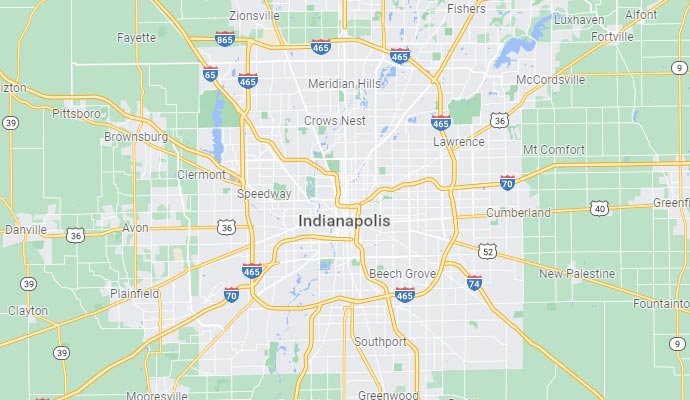Foundation Settling vs. Foundation Problems
Every home settles over time. This is simply a result of the downward force of gravity on physical structures. However, only a certain amount of settlement and movement should occur.
If too much settlement happens, serious foundational problems could result. Do you know the differences between the two?
What is Foundation Settling?
Settling is essentially the all-encompassing term used to describe the natural changes that take place in a Indianapolis foundation over the years. The two major culprits of Indianapolis foundation settling are time and weather.
Over time, a new home gradually sinks into the ground, and a lot depends on the soil composition and climate. Good builders and contractors are familiar with the local soil and can accurately predict how much a Indianapolis foundation will settle over time, but there is no exact science.
If there’s been improper soil preparation or extreme weather conditions, it’s possible for brand new homes (less than five years old) to see substantial settlement. This generally happens when a home is built during a drought, and a rainy season occurs after construction is completed. The clay soil expands and the house experiences some settlement. Then, if another drought follows, the clay will retract and it’s possible to see a few inches of settlement in a matter of weeks or months.
Every house will see some settlement over the years. In fact, a few inches of settlement is nothing to worry about (assuming this settlement is evenly distributed across the structure). Soil expansion and contraction cannot be controlled and quality construction will hold up under normal variances.
It should also be noted that there’s a difference between initial settlement and ongoing settlement due to site factors. Initial settlement happens within the first few years of construction – as mentioned above. Ongoing settlement due to site factors in the continued settlement that’s related to site-specific issues. In other words, this is settlement that will likely continue over time and needs to be monitored and handled.
What are Foundation Problems?
The problem occurs when there’s extreme/chronic Indianapolis foundation settling or other issues that compromise the integrity of the home’s foundation. Two of the major types of Indianapolis foundation problems include Indianapolis foundation shrinkage and Indianapolis foundation expansion.
1. Foundation Shrinkage
Concrete naturally shrinks as part of the curation process. This shrinkage is even visible to the naked eye if you look for the gaps between the edges of a slab and the Indianapolis foundation wall. This isn’t just the process of the concrete losing water but is actually part of the chemical reaction that takes place.
Shrinkage will vary depending on a number of independent elements, including the type of concrete mix, amount of water used, aggregate type, humidity and temperature, sun exposure, groundwater, and other conditions. Generally speaking, shrinkage will occur underneath Indianapolis basement windows and around doorways. If no control joints were used, it’s also possible for shrinkage to occur near the middle of a large wall.
2. Foundation Expansion
For foundations that use brick, expansion is quite common. This is the result of brick’s natural tendency to slowly grow over time. While all brick will expand, brick walls that are exposed above-grade are subject to more rapid size gains. Brick walls beneath the ground tend to grow because of moisture gain – especially in freezing climates.
Foundation Settling or Major Problem?
The tricky part for homeowners is determining whether cracks and issues are the results of normal Indianapolis foundation settling or a major Indianapolis foundation problem. Sometimes, there’s no reason at all to worry. Other times, it’s important to take action.
In most cases, normal Indianapolis foundation settling will be unnoticeable to the homeowner. If it is noticeable, the symptoms will consist of small cracks that don’t seem to get any larger over time. However, if any of the following signs are present, then they could indicate a larger issue:
- Wall cracks: If you see jagged cracks running at 45-degree angles throughout your home, this is a telltale sign that your Indianapolis foundation is shifting. In fact, it’s shifting so much that the sheetrock is being torn apart.
- Sticking windows and doors:Have you noticed doors and windows sticking for no apparent reason? While a single door or window isn’t reason enough to worry, consider the possibility of Indianapolis foundation problems if it’s happening across the board. This is the result of door and window frames twisting out of balance.
- Issues with the roof: While wall cracks and stuck windows and doors are easily detectable, you can find out more by looking upwards. When the Indianapolis foundation is compromised, the tallest point of the structure will also be compromised. Look for cracks, gaps, and other signs on the top story of your home.
- Water in the basement: If you have a basement, check for the presence of water after rainstorms. While water can sometimes leak into the Indianapolis basement of a home with a solid foundation, seepage is quite common when the Indianapolis foundation has been compromised. If you’ve noticed other symptoms, try verifying your assumption by looking for water.
As you can see, serious symptoms like these indicate that your Indianapolis foundation is undergoing something other than standard settlement. Keep track of these symptoms and if they seem to be getting worse, it’s probably time to have a professional come out and assess the situation. The sooner you fix your Indianapolis foundation problems, the better off you’ll be.
Details
Published: 30 January 2018

















